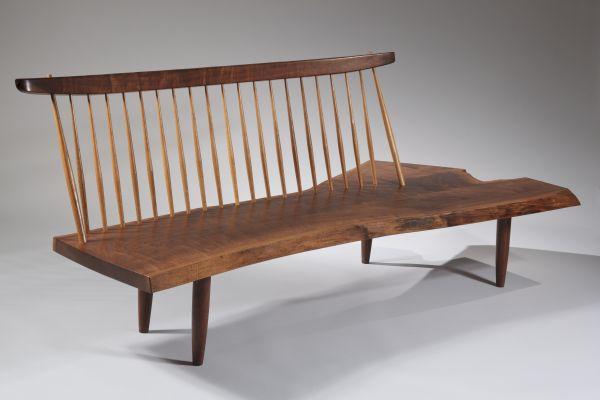
Conoid Bench with Back Rest
Artist: George Katsutoshi Nakashima (American, 1905-1990)
Date: 1979
Dimensions:
H: 2 ft., 7.25 in. (79.4 cm); L: 6 ft., 10 in. (208.3 cm); Depth: 2 ft., 9.25 in. (84.5 cm).
Medium: American black walnut and hickory with East Indian rosewood butterfly; planed, polished, spoke-shaved, and joined with tenons
Classification: Furniture
Credit Line: Gift of Francis Asbeck
Object number: 2012.79
Label Text:Named for the conical roof of the artist’s studio, Conoid Bench retains the original form of its component boards. A native of the Pacific Northwest, Nakashima carried a deep childhood appreciation for nature into his adult career. This bench is designed according to the individual attributes of the wood planks selected for the bench. Fashioned from different trees, no two benches in this series look alike.
Nakashima’s reverence for nature and his desire to maintain the essence and beauty of the tree are evident in his furniture designs. Without veneer, the organic material shines through, and the free edges of the bench remain true to the tree’s original, irregular form. A small split at the back of the bench is not disguised with artificial material; instead, it is joined with a rosewood butterfly. Nakashima’s signature structural technique maintains both the organic aesthetic and the structural integrity of the piece.
Nakashima’s reverence for nature and his desire to maintain the essence and beauty of the tree are evident in his furniture designs. Without veneer, the organic material shines through, and the free edges of the bench remain true to the tree’s original, irregular form. A small split at the back of the bench is not disguised with artificial material; instead, it is joined with a rosewood butterfly. Nakashima’s signature structural technique maintains both the organic aesthetic and the structural integrity of the piece.
DescriptionThe bench consists of short walnut legs with shoulder tenons that are fitted into the bottom of the seat and support the free-edge walnut plank forming the seat from which turned hickory spindles and a crest rail rise to form the back. A signature rosewood butterfly join secures and accentuates a crack in the plank’s crotch at proper left. The back support consists of 21 hickory spindles tenoned into the seat and into the walnut crest rail. The two thicker end spindles, positioned slightly forward, are tenoned all the way through the crest rail and secured with contrasting wedges.
The bench consists of short walnut legs with shoulder tenons that are fitted into the bottom of the seat and support the free-edge walnut plank forming the seat from which turned hickory spindles and a crest rail rise to form the back. A signature rosewood butterfly join secures and accentuates a crack in the plank’s crotch at proper left. The back support consists of 21 hickory spindles tenoned into the seat and into the walnut crest rail. The two thicker end spindles, positioned slightly forward, are tenoned all the way through the crest rail and secured with contrasting wedges.
The bench consists of short walnut legs with shoulder tenons that are fitted into the bottom of the seat and support the free-edge walnut plank forming the seat from which turned hickory spindles and a crest rail rise to form the back. A signature rosewood butterfly join secures and accentuates a crack in the plank’s crotch at proper left. The back support consists of 21 hickory spindles tenoned into the seat and into the walnut crest rail. The two thicker end spindles, positioned slightly forward, are tenoned all the way through the crest rail and secured with contrasting wedges.
On view
In Collection(s)

